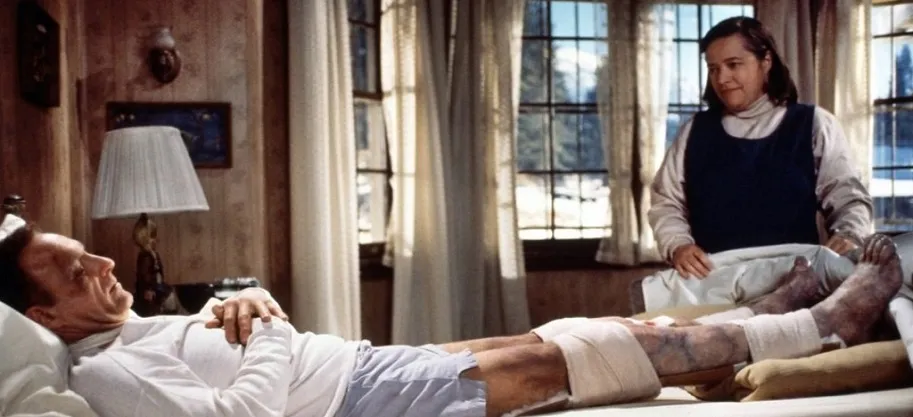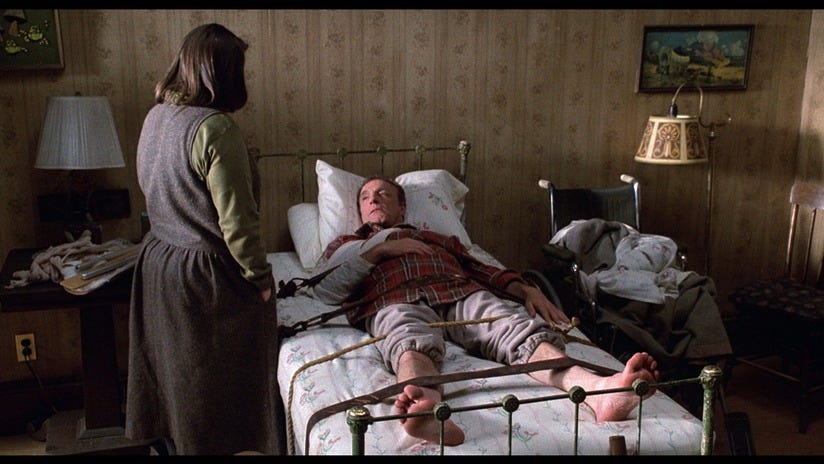Misery (1990)

DIRECTOR: Rob Reiner
CAST: James Caan, Kathy Bates, Richard Farnsworth, Frances Sternhagen, Lauren Bacall
REVIEW:
Following 1986’s Stand By Me, Rob Reiner has now chosen to bring another one of Stephen King’s stories to the screen, this time Misery, an adaptation of King’s same-named 1987 novel. Misery delves further into the horror genre—well-traversed territory for King—than the coming-of-age story Stand By Me but avoids any supernatural elements. The horror here is of the comparatively banal variety but one suspects may be a fear sprung from Stephen King’s own imagination: the obsessed fan.
Like many a Stephen King protagonist (see also The Shining and IT), our main character is a writer, namely Paul Sheldon (James Caan), a successful novelist whose biggest claim to fame is a popular series of Victorian romance novels starring his heroine Misery Chastain. But while it has brought him fame and fortune, Paul is sick of Misery and in his latest novel, he’s finally killed her off (he’s already got his next manuscript, a gritty tale about urban youth, tucked in his bag). But Paul’s plans hit a snag when his car goes off the road in a blizzard and a half-crippled Paul finds himself at the mercy of his rescuer, a seemingly pleasant, folksy woman named Annie Wilkes (Kathy Bates) who professes to be his number one fan. But it’s not long before Paul realizes he’s fallen into the clutches of a madwoman, and things escalate when Annie gets her hands on his final Misery novel and isn’t happy with the ending. Soon, Annie is holding Paul prisoner and forcing him to resurrect Misery in a sequel, while the wheelchair-bound Paul plots a way to somehow make an escape.

The “horror” in Misery is of the slow-burn, claustrophobic suspense variety. Reiner and screenwriter William Goldman (who wrote the original novel The Princess Bride which had been previously adapted by Reiner) don’t stray far from King’s novel—there are a few differences here and there, but nothing major—which did a deviously simplistic job of setting up the premise. The outside world believes Paul is dead; we occasionally cut away from what is predominantly a two-person show to the search involving his literary agent (Lauren Bacall) back in New York City and the local crusty old sheriff (Richard Farnsworth) and his wife/deputy (Frances Sternhagen), who are the only other people in the movie of any consequence (and the biggest inventions of the movie and differences from the book, in which Paul and Annie were basically the only characters). Paul is first trapped in a bed, then only slightly upgrades to a wheelchair. This puts him at a disadvantage and tips the scales of power in Annie’s favor, both forcing him to devise clever escape attempts—there is a nail-biting scene where he struggles to get back in place as if nothing had happened before Annie comes home and catches him up and about—and intensifies the unease about being helplessly at the mercy of Annie’s capricious whims and what she might do next. And there’s not much we can safely put past Annie; she’s frightening because she’s in the position of power and because she’s unstable and unpredictable. Thus commences a slow burn battle of wits and wills in which the author must write his way out of his current predicament. And speaking of, King also has a few things to say about writing. Like many famous authors, Paul has had to compromise between what he really wants to write and what sells—he wrote his original Misery Chastain novel as a struggling writer just trying to put food on the table, then got trapped by his own success into writing nothing but Misery stories until he couldn’t stand the character he’d created—and one has to be a writer to fully understand the pain of the scene in which Annie inflicts the cruelest punishment possible for a writer when she forces him to burn his manuscript. The movie’s most unforgettable scene, however, requires no such specificity of the audience to be tough to watch. There’s been far more gruesome horror movie moments than this, but only a viewer made of stern stuff will resist a cringe, although it’s worth noting Paul gets off easier than in the book (Goldman argued for a faithful adaptation but Reiner felt it was too much, also toning down or completely leaving out a couple of the book’s other grisliest moments). Which is not to say the movie plays completely straight. A low-key but hard-to-miss undercurrent of dark humor runs throughout the movie; some of Annie’s unhinged tirades are almost funny in an uneasy kind of way, and the movie is not without a campy element, especially by the end where James Caan and Kathy Bates are rolling around wrestling on the floor and typewriters and manuscripts are being used as weapons (one of the book’s most over-the-top moments of violence was completely cut however, after Reiner decided it would be unintentionally funny onscreen).

This is nearly—not quite, but nearly—a two-person show (given the limited settings, it wouldn’t take much tweaking to adapt this into a two-person stage play), and James Caan and Kathy Bates are an effective duo. Unusually for our “hero” and leading man, Caan interestingly has the somewhat thankless role, stuck in a bed and/or a wheelchair for the vast majority of his screentime. Sometimes intense and hyper—his Sonny in The Godfather, for example—he’s forced here by the very nature of his role to be controlled and passive. Indeed, apparently quite a few leading men decided Paul Sheldon was too thankless of a role for them; before Caan was finally cast, William Hurt, Kevin Kline, Michael Douglas, Harrison Ford, Dustin Hoffman, Robert De Niro, Al Pacino, Richard Dreyfuss, Gene Hackman, and Robert Redford had all turned it down (the only one interested, Warren Beatty, wanted to tweak it to make Paul a less passive character). For his part, Caan claimed he took the part for the very reason that it was different than his usual kind of role, and because it represented an acting challenge. Few would deny however, that it’s Kathy Bates (a then-unknown, recommended by Goldman) who gets the plum, juicy role of Annie Wilkes, who is destined to go down as one of the great horror characters and the scariest woman since Glenn Close’s Alex in 1987’s Fatal Attraction. Bates mesmerizes with an uncanny knack for whiplashing at the drop of a hat between sweet, even shy solicitude and bursts of unhinged rage. This is the kind of character that calls for a little scenery-chewing, but while it would be a lie to say Bates’ performance is exactly subdued, she avoids the level of over-the-top histrionics that would have turned Annie into a cartoon. She plays it straight-faced and matter-of-fact, and partly because she’s so believable, she’s genuinely frightening. Caan is fine, but the performance likely to be talked about when Misery comes up is Bates. Other than Caan and Bates, longtime character actor Richard Farnsworth and Frances Sternhagen provide a little low-key humor in the banter between the crusty old Sheriff and his wife/deputy, while Lauren Bacall has a glorified cameo.
Misery feels just a tad slight, small-scale banal horror rather than the likes of The Shining, but if the narrative is nothing groundbreaking, it works due to a sense of slow-burn unease and claustrophobic tension. That, and Kathy Bates’ indelible performance, make it worth a look.
* * *